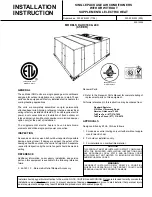
Page 10
NOTE
-
When installing refrigerant lines longer than 15.2
meters, see the Lennox Refrigerant Piping Design and
Fabrication Guidelines, CORP. 9351-L9, or contact Len-
nox Technical Support Product Applications for assis-
tance. To obtain the correct information from Lennox, be
sure to communicate the following information: Model and
capacity.
1 -
Route the suction and liquid lines from the fittings
on the indoor coil to the fittings on the outdoor unit.
Run the lines in a direct path, avoiding unnecessary
turns and bends.
2 - Make sure that the suction line is insulated over the
entire exposed length and that neither suction nor
liquid lines are in direct contact with floors, walls,
duct system, floor joists, or other piping.
3 - To avoid damaging the rubber grommets in the
cabinet while brazing, slide the rubber grommets
over the refrigerant lines until they are away from
the heat source.
NOTE
-
Place wet rags against piping plate and around
suction line connections.
4 - Connect the suction and liquid lines to the evaporator
coil. Take care to protect the cabinet and internal
components as detailed in figure 14.
5 -
Braze using an alloy of silver or copper and
phosphorus with a melting point above 1,100°F
(593°C).
NOTE
-
Do not use soft solder.
6 - Allow refrigerant pipes to cool to room temperature.
NOTE
-
Make sure to route copper refrigerant tubing away
from sharp edges and make sure that it does not touch
other metal surfaces. This prevents damage caused by
vibration or metal-on-metal contact
.
7 - Reinstall the rubber grommets into the refrigerant
piping panel.
NOTE
-
Make sure expansion valve capillary tube is not
touching metal edges or copper tubing.
8 - Make sure outdoor unit has been placed according
to the Installation Instructions and is connected to
the refrigerant lines






































